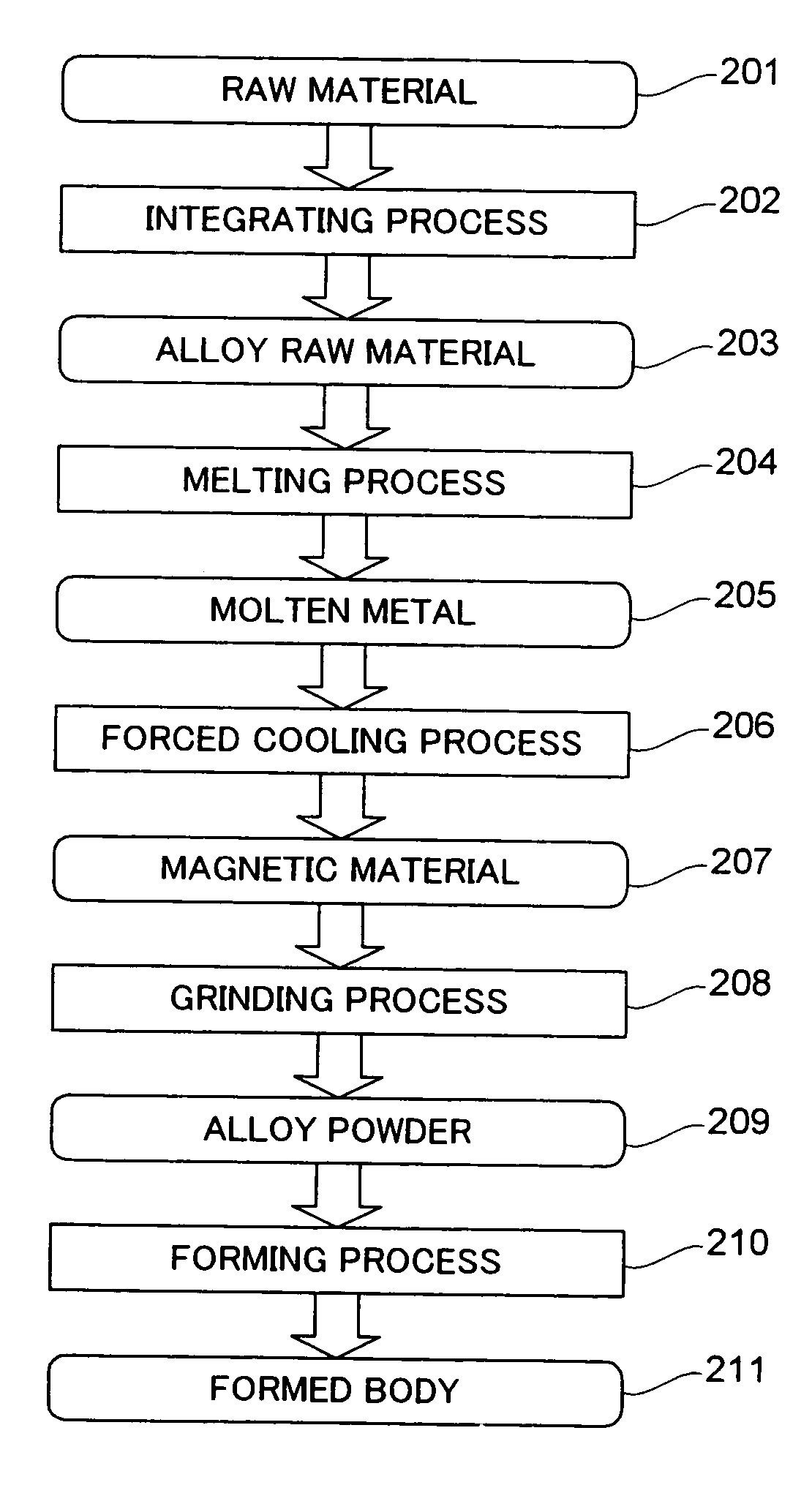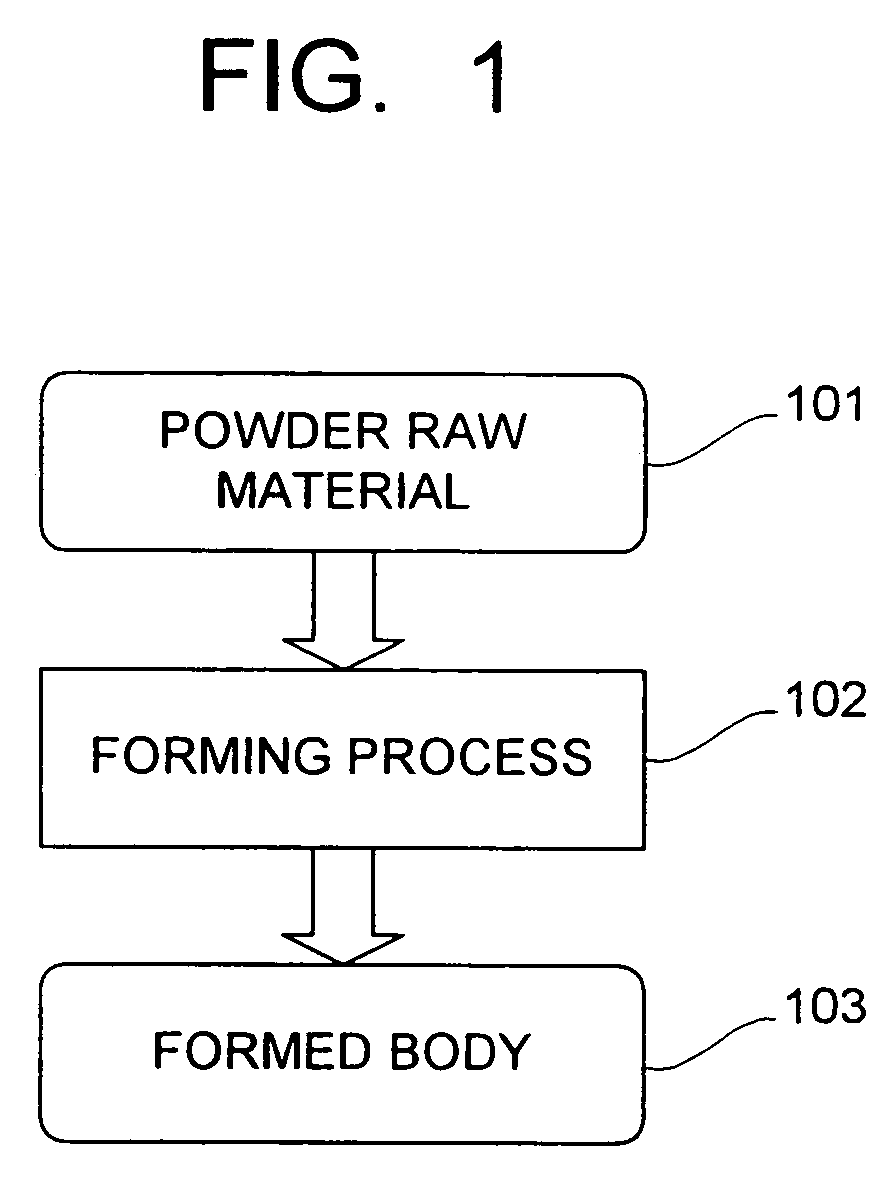Magnetic material and manufacturing method thereof
a technology of magnetic materials and manufacturing methods, applied in the direction of magnetic materials, basic electric elements, magnetic bodies, etc., can solve the problems of reducing the uniformity of composition between particles, difficult grinding, and extremely low productivity of particles, and achieve the effect of increasing the manufacturing efficiency of magnetic materials having nazn13 crystal structure phas
- Summary
- Abstract
- Description
- Claims
- Application Information
AI Technical Summary
Benefits of technology
Problems solved by technology
Method used
Image
Examples
example 1
[0066] At first, LaSi powder with an average particle size of a 10 μm, Fe powder with the average particle size of a 6 μm, and Si powder with the average particle size of a 7 μm are prepared, and these are blended so as to be a stoichiometry of La(Fe0.88 Si0.12)13. Further, they are mixed and miniaturized so that the average particle size of the mixture becomes to be 5 μm. A composition ratio of respective elements within the mixed powder (powder raw material) is as follows: La is approximately 7.2 at.%; Fe is approximately 81.7 at.%; and Si is approximately 11.1 at.%.
[0067] Next, the miniaturized mixed powder (powder raw material) is sintered by using a pulse current pressure sintering equipment. The sintering is performed under a condition that a degree of vacuum within a chamber is 2 Pa, and a direct pulse current with a maximum voltage of 3.2 V, and a maximum current per pressure-receiving area of 500 A / cm2 is flowed while a sample is applied a pressure of 40 MPa. As a pulse co...
example 2
[0068] After the respective powders of LaSi, Fe, Co, Si are mixed to be La(Fe0.83Co0.05Si0.12)13, the pulse current pressure sintering is performed under the same condition with Example 1. The composition ratio of the respective elements within the mixture to be a raw material is as follows: La is approximately 7.2 at.%; Fe is approximately 77.1 at.%; Co is approximately 4.6 at.%; and Si is approximately 11.1 at.%.
example 3
[0069] After the respective powders of LaSi, Fe, Co, Si are mixed to be La(Fe0.88Co0.03Si0.09)13, the pulse current pressure sintering is performed under the same condition with Example 1. The composition ratio of the respective elements within the mixture to be the raw material is as follows: La is approximately 7.2 at.%; Fe is approximately 81.7 at.%; Co is approximately 2.8 at.%; and Si is approximately 8.3 at.%.
[0070] A powder X-ray diffraction is performed to investigate a constitutional phase of the sintered body of the magnetic material obtained as stated above. An X-ray diffraction result of the magnetic material according to Example 1 is shown in FIG. 3. As it is obvious from FIG. 3, the NaZn13 crystal structure phase is generated as a main phase, and a main peak intensity of the NaZn13 crystal structure phase is 3.34 times of the main peak intensity of the α-Fe phase.
[0071] A generation ratio of the NaZn13 crystal structure phase is asked from the powder X-ray diffractio...
PUM
| Property | Measurement | Unit |
|---|---|---|
| Particle size | aaaaa | aaaaa |
| Particle size | aaaaa | aaaaa |
| Pressure | aaaaa | aaaaa |
Abstract
Description
Claims
Application Information
 Login to View More
Login to View More - R&D
- Intellectual Property
- Life Sciences
- Materials
- Tech Scout
- Unparalleled Data Quality
- Higher Quality Content
- 60% Fewer Hallucinations
Browse by: Latest US Patents, China's latest patents, Technical Efficacy Thesaurus, Application Domain, Technology Topic, Popular Technical Reports.
© 2025 PatSnap. All rights reserved.Legal|Privacy policy|Modern Slavery Act Transparency Statement|Sitemap|About US| Contact US: help@patsnap.com



